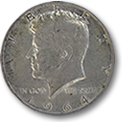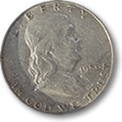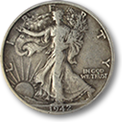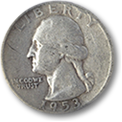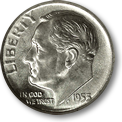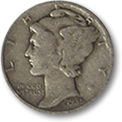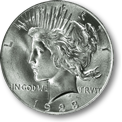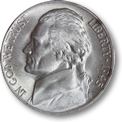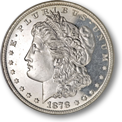
The History of the Silver Peace Dollar
Armistice Day, November 11, 1919 was a remarkable experience still remembered by centurions. People all across America flooded into the streets, dancing. Imagine! They did this because the World War I had been publicly billed as "the war to end all wars" and it had been won. The energy in the streets of America has never been so united around a single celebration of victory. History shows the public did not really want war, and huge world wars were nothing the public had in mind for our nation. Dancing ensued in the streets, and was followed by the establishment of the League of Nations; an organization everyone hoped would work to prevent any further warring between nations. Americans as a united collective group of states was not quite ready for a League of Nations, however the hunger for peace in this country was palpable, and this need was met by the public's embrace of a new American coin: The Silver Peace Dollar.The love of independence and competition still thrives in America. This was even more evident after World War I. Our nation had placed a huge meaning and competition based on the development of coins in our country. We were holding annual contests to flush into the public eye, the very best artists and designers our nation had to offer. These designs were being stamped onto our coinage at the US Mint departments located in four major hubs in the nation. San Francisco, Washington D.C., Denver, and Philadelphia.
The public was over-ready for a silver coin to commemorate peace. To commemorate the restoration of peace, the US Mint department took advantage of this wide-spread sentiment. The current need in the economy was for silver dollars. This shortage presented a unique opportunity. Silver mining interests were surging into the political and economic climates. Utilizing the momentum of the times, the American Numismatic Association played a key role in submission of the Peace Dollar proposal. The US Mint department was being required to respond to the Pittman Act of 1918, a law enacted through the influence and wealth of the silver mining corporations. History often forgets to remember that the nation had just surrendered its power to the corporations, an act the founding fathers had worked diligently to prevent.
The Tea Party actions were a direct affront to the corporate oppression that was occurring in England, and they were hoping to prevent the take-over of corporate greed in the new Americas. The Boston Tea Party was such a resistance of conscience, and this eventually led to the civil wars that threatened the economy, the democratic sovereignty and the financial independence of this country. The US Military had become "corporatized" in that corporate lobbyists had realized their impact and influence on political legislators. This under-documented reality led to military interests in financial gain through competition with neighboring countries. It also helped improve the American economy by creating jobs and an inter-national need for our natural resources.
Under the measure of the Pittman Act, the government was expected to melt up to 350 million existing silver dollars. They were mandated to then convert the silver into bullion and then sell the metal or convert it to produce new silver coinage. Then, the mandate required them to strike replacement dollars for any and all that were melted. This was seen as evidence to many that corporate greed was now inherently involved in American decision making through use of our democratic systems, and the system may have been hijacked by the wealthy influence of silver corporations.
For many this was confirmed when, in the 1920's the international railway system was disassembled by the car manufacturing corporations that completely succeeded in destroying local small-train systems, by removal of the tracks going through city centers such as Los Angeles. The highly effective and beneficial railway, electric trolley and bus transportation systems, were then replaced in favor of forcing Americans to buy cars as individuals in order to be able to travel to work and get transport to family and other normal business. A coup that garnished billions for the car manufacturing corporations such as General Motors was obtained when tainted Judges gave the American corporation the "right of person-hood", an extremely powerful legal standing that opened doors to massive dominance of our air waves and printed media. Up until that time, a common American could travel great distances needing only a nickel or dime, depending on the year and destination.
The law also was beneficial for our new corporate partner; Great Brittan during 1918 and 1919. An ally in the first World War (supposedly to be the last), Great Britain desperately needed silver in the bullion form, to benefit their colonial rule of the people of India during the great financial crisis that took hold during Britain's occupation of this great Indian nation. Eventually, over $259,121,554 in silver bullion was sold to Great Britain and the US Mint melted 11,111,168 silver dollars previously in circulation, in order to make new raw material of new subsidiary coins for the USA.
These melted coins represented half of the entire production of standard silver dollars; however, this was no blow to the new post war, or post corporate allies such as Great Britain. Silver dollars were seen as only being of limited use, most Americans were lucky to obtain the pennies, dimes, quarters and nickels for massive common use. Commercial use of the silver dollars was minimal as well, and reflecting this reality is the fact that none had been produced since 1904. Remaining inventories seemed sufficient for commercial needs at that time.
There was no compelling need to produce new silver dollars, save the mandate of the Pittman Act. Silver magnates wanted more profits, and naturally, the US Mint was engaged to comply. It was now 1921 and the price of silver had fallen in the post war economy, so the post-war Morgan Dollar was resurrected for this purpose. Record numbers were produced in a single year. Eighty six million were produced, the highest one-year figure in the Morgan Silver Dollar series.
A coincidence came into play here. On May 9, 1921, legislation in Congress was passed calling for a new silver dollar marking the post-war peace. The coin was described by its sponsors as "an appropriate design commemorative of the termination of the war between the Imperial German Government and the Government of the People of The United States." Interesting enough, is the fact that Congress adjourned without taking action on this measure. The Morgan Dollar was produced for more than a legal minimum of 25 years, and this freed the US Mint to replace this dollar without further congressional approval.
Movement forward became a momentum and the traditional call for the design competition for the coin design was engaged. The Federal Commission of Fine Arts quickly organized a competition between a small group of the nation's renowned medalists. The nine artists included Victor D. Brenner, Adolf A. Weinman and Hermon A. MacNeil-- all artists who had previously presented the Mint with US coin designs that were released into circulation. The winner, however, was an Italian immigrant by the name of Anthony de Francisci, whose presented portrait was a finely chiseled portrait of Lady Liberty, modeled by his young wife, Theresa. The reverse of this coin hosts an image of an eagle sitting in repose atop a crag in a cliff, and is seen peering toward the sun from within a series of sun-rays. The word "PEACE" is superimposed on the rock-cliff. It remains the only US coin bearing this motto.
The production of the 1921 peace dollar didn't get underway until December. Over a million of the coins were produced in this initial run. This showed a flaw in the relief; it was too high and die strikes caused excessive die breakage. This problem was resolved in 1922, although many feel the aesthetic appeal of the coin was reduced as well.
In 1928 all the criteria of the Pittman Act had been met. Production stopped and with the onset of the great depression, and did not receive any form of curtain-call until 1934. Silver Certificates were now the new investment trend, and the 1934 "S" proved to be a key coin in this series along with the 1921 and the 1928 circulation releases. Matte proofs exist for 1921 and 1922, only. These coins bear the Mint mark below the word "ONE" on its reverse.
Preference for the silver dollar designs didn't emerge until the 1960's. New interest had to be generated by the Treasury through certificate redemption around the publicity being cranked out by sales of $1,000 bags of silver dollars to anyone with enough money to buy them. Although the silver dollars had been readily available for decades, according to Treasury Department policy, the silver Peace Dollar was paid out before the Morgan Dollar would be released. Smaller denomination collections were easier to assemble, and nature took its course. In the 1930's and 40's the silver dollar represented a considerable amount of money. One silver dollar was enough for five dozen eggs, or ten boxes of the ever-popular "Wheaties." By the 1960's enthusiasm for both the Morgan Dollar and the Peace Dollar were finally fired up by the eventual release of the Morgan Dollar going back into circulation. Suddenly, collectors sought them both.
Peace Dollar sets include just 24 coins. None of them are particularly rare. Many strive to collect the complete date and mint sets. It is difficult to find high-grade coins although weak die strikes were common and the broad and open design-style made them susceptible to wear and damage. The points to check for wear include Liberty's face, neck and hair over her ear and above her forehead. On the reverse, wear is commonly seen on the eagle's wing, leg and head.
The end of the silver Peace Dollar run was as equally and ominously as symbolic as its birth. In 1939 World War II erupted in Europe. The design came close to having another run in 1964 when Congress wanted to help supply Nevada casinos with more silver coins. 45 million coins were authorized for production as the smaller silver coins were quickly disappearing. Many saw this move as a way to serve special interests, and after the Denver Mint had produced 316,076 Peace Dollars dated 1964, in 1965 president Johnson then rescinded the order. Even though all the coins were supposed to be recalled and melted, rumors persist today of some of them surviving.
Collectors who understand and track the historical information that is available by reviewing the circulation runs and political motivations of the US Treasury Department, not only obtain valuable collection information. These folks also learn previously un-released histories our nation has been perhaps reluctant to release more publicly due to its un-popular nature. It is for the benefit of the common American people. Popular public demand has a huge impact on the decision makers of our nation. For a collector of US American coins, this can be an advantage. As a collector, be sure to make your voice heard when working to improve the political conditions of the common business venture, that serves to support the economic reality of our American people and families.








